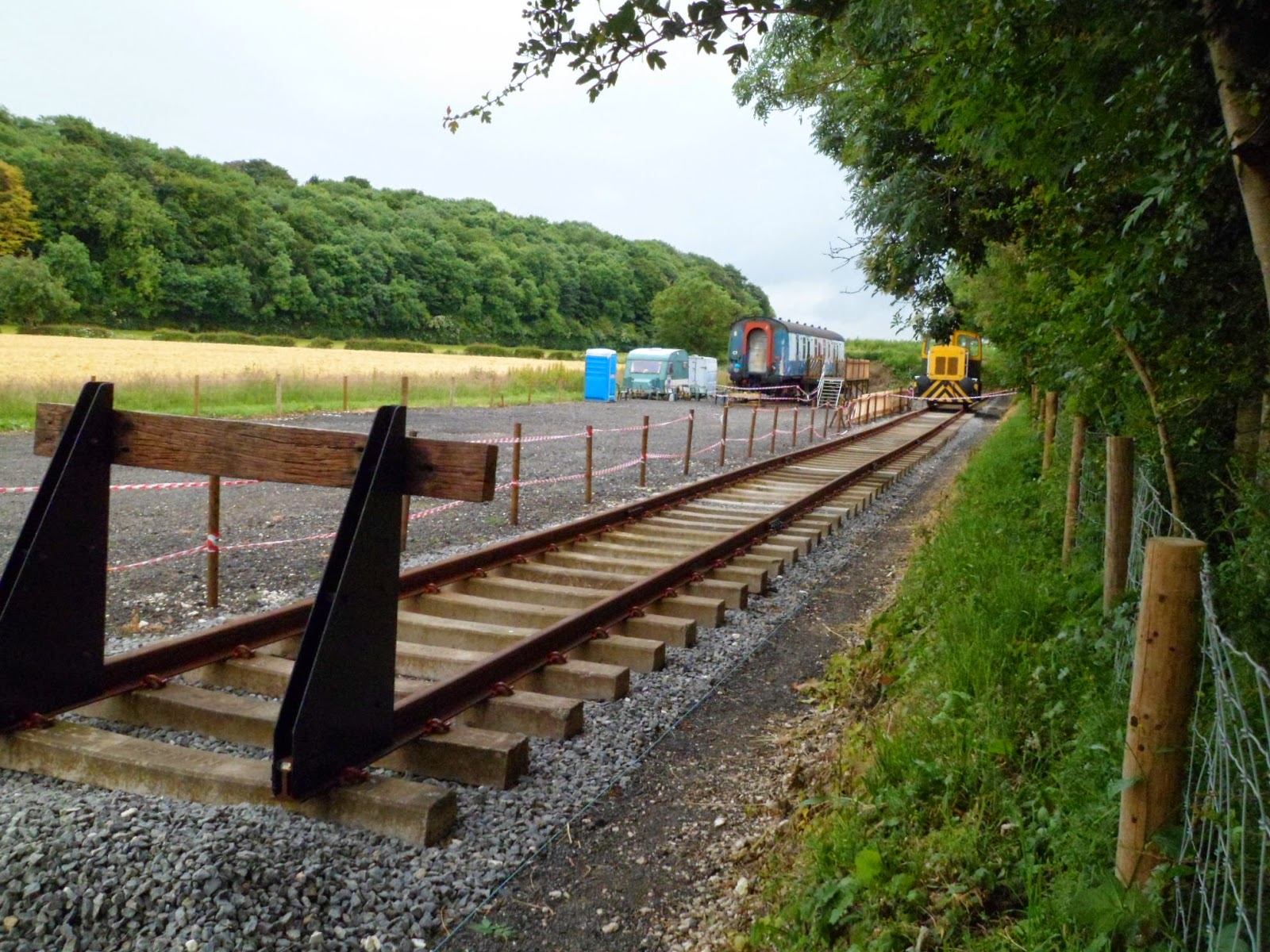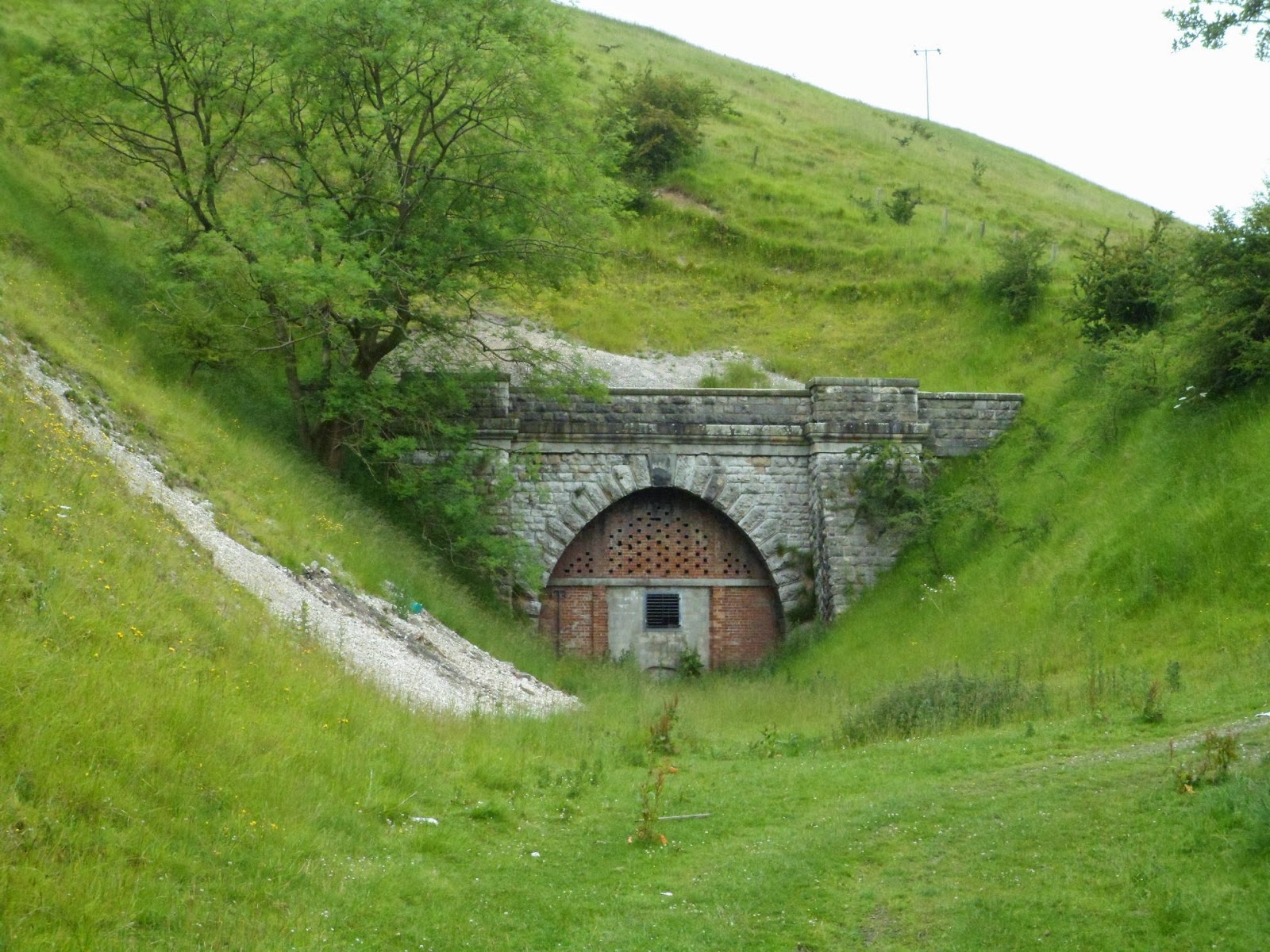An unexpected Quest yesterday - I was planning to spend the day sitting in the flat, reading a book, eat snacks and being tormented by Plume, but Faux-Bro had other ideas. As it was his day off, and I wasn't working 'til 5pm he suggested going out to the Wolds to have a nosey round the deserted medieval village of Wharram Percy, so immediately in my mind, I started plotting how many stations I could "accidentally" include in the trip.
First stop was a quick fag-break at the picnic site at Fimber roundabout, which just so happened to be the location of the (now demolished) Sledmere & Fimber station. Virtually all trace of the railway has gone, to be replaced by grass, benches, and old people drinking tea from a wooden hut.
 |
| Sledmere & Fimber - possibly a bit of an old coal bunker? |
After reading various notice boards about the history and wildlife in the area, I wandered round the back of the tea-building, and crept off into the nettles (shorts + nettles = not overly wise) to hunt for relics. There was a bit of old stone wall, which was presumably part of the platform, or maybe a foundation of the station house, and a curious concrete structure with a tree growing out of it, which may have been the stationmaster's coal hole. Who knows?

The oddest thing we found (relatively speaking - things got considerably creepier later, but more anon.) was a tiny plastic figurine of an angel, nestling in the undergrowth. What it was there for, I do not know...
 With the old station thoroughly investigated, I set off along the main road, past the crossing keepers' cottage (now a bed & breakfast), to where the Yorkshire Wolds Railway people are establishing themselves. Their site isn't open to the public just yet, but can be easily seen as it's right next the fence - no trespassing required! Hurrah! Their current plan is to run trains from a new station at Fimber Halt (just about visible in the picture, near the yellow shunter) to a terminus at Wetwang Green Lane, and once open it will be the only steam railway in East Yorkshire. Ooooh!
With the old station thoroughly investigated, I set off along the main road, past the crossing keepers' cottage (now a bed & breakfast), to where the Yorkshire Wolds Railway people are establishing themselves. Their site isn't open to the public just yet, but can be easily seen as it's right next the fence - no trespassing required! Hurrah! Their current plan is to run trains from a new station at Fimber Halt (just about visible in the picture, near the yellow shunter) to a terminus at Wetwang Green Lane, and once open it will be the only steam railway in East Yorkshire. Ooooh!
Back in the car (sorry Scott!), and still with the intention of getting to Wharram Percy, I directed Faux-Bro onto a country lane, rather than the main road, on the pretense it was more scenic. After a mile or so, I persuaded him to let me out so I could pose about where Burdale station used to be. At first glance, this looked like it was going to be totally impossible (impassable?) as the station here was on top of an embankment, which is now covered in nettles and brambles, with barbed wire all round it. Oh dear!
 |
| Good place to hide a body... |
We walked along the fence line, looking for a suitable access point, and eventually stumbled on a way up, but even then, the way back to the station remnants looked totally blocked. As a consolation, I suggested a wander into the old quarry instead, which Faux-Bro accepted as a good substitute. Burdale Quarry is pretty huge, but has been closed nearly as long as the railway line - which shut for good in 1958 - so now it's being colonised by rabbits, orchids, and the occasional bird of prey. I think it might be a nature reserve, but I'm not sure.
Having now resigned myself to the fact I wasn't going to actually get right up to the station itself, we agreed that a walk along to the tunnel mouth would be a pleasing substitute. After navigating through a herd of cows (who all found it necessary to herald our passing with extravagant squirts of shite), the portal was before us, but was, quite unsurprisingly bricked up, with just a grill part way up for ventilation. Wanting to peer inside, I gripped the rusty metal bars, and pulled myself up to have a look. The grill hinged outwards, like a door, inviting us in...
 Descending the ladder inside, into the void, the darkness was positively velvety, and the air much cooler and damper than outside. The tunnel stretched off into total blackness, so we couldn't go too far, not having brought torches. I was inspecting the scratched-in graffiti on the brickwork when all of a sudden Faux-Bro shouted "A skull!", but it wasn't human, just a sheep. Is it odd I was slightly disappointed?
Descending the ladder inside, into the void, the darkness was positively velvety, and the air much cooler and damper than outside. The tunnel stretched off into total blackness, so we couldn't go too far, not having brought torches. I was inspecting the scratched-in graffiti on the brickwork when all of a sudden Faux-Bro shouted "A skull!", but it wasn't human, just a sheep. Is it odd I was slightly disappointed?
Back out in the open air, after passing back through the still-shitting cows, we walked back towards the car. Somehow, we managed to locate the ruined station platforms, despite seemingly walking the same way we'd already been! There's not much left, just stones poking out of the undergrowth. The main buildings fell down long ago and have returned to nature.
 |
| Burdale - not much remains... |
But anyway! Onward!
 Time was ticking on, so we drove off, over the head of the valley, to finally get to Wharram Percy. Except we didn't - not straight away anyway. First of all there was the distraction of the opposite end of the tunnel - certainly no exploration possibilities this time though, as the approach cutting is filled with mud and slime and the grill is considerably higher anyway. We had a poke about in a derelict platelayers' hut, and then finally got around to visiting the deserted medieval village.
Time was ticking on, so we drove off, over the head of the valley, to finally get to Wharram Percy. Except we didn't - not straight away anyway. First of all there was the distraction of the opposite end of the tunnel - certainly no exploration possibilities this time though, as the approach cutting is filled with mud and slime and the grill is considerably higher anyway. We had a poke about in a derelict platelayers' hut, and then finally got around to visiting the deserted medieval village. Irritatingly, despite the pleasant weather all morning, the sky gods decided it would now be a good time to send down some rain! The only place to shelter was the ruin of the church, but that was already occupied by a group of cubs (too young to be proper scouts) messing about and eating sandwiches, so we stood under a tree by the pond and had a quick smoke.
Irritatingly, despite the pleasant weather all morning, the sky gods decided it would now be a good time to send down some rain! The only place to shelter was the ruin of the church, but that was already occupied by a group of cubs (too young to be proper scouts) messing about and eating sandwiches, so we stood under a tree by the pond and had a quick smoke.
The rain eventually eased off, so rather than heading straight back to the car park, we walked back to where the old railway line crossed the path, and turned northward towards Wharram's old station. The trackbed here is now used as part of the Centenary Way (I still haven't worked out what it's the centenary of), and is bounded on both sides by bushes.
 |
Spying an interesting gap in the trees to the east, we slipped through into post-apocalyptic Soviet Russia., or as it's more commonly known: The Wharram Quarry chalk-crusher. With more concrete, rust and broken glass than you could shake a stick at, we were reminded of Pripiyat - the city abandoned after the Chernobyl disaster. It's impressive how nature can gradually reclaim something industrial and ugly, and make it into quite a magical environment. The only sour note was the vast amount of empty shotgun cartridges lying around in heaps...
Not wishing to be peppered with lead, we rejoined the path and very shortly were at the former Wharram station. It's fared considerably better than the other two we visited, and has been converted into a very tasteful private house, but not over-done - it still bears it's railway origins with pride. Even the water tower remains as an unusual garden feature!
 |
| Wharram |































